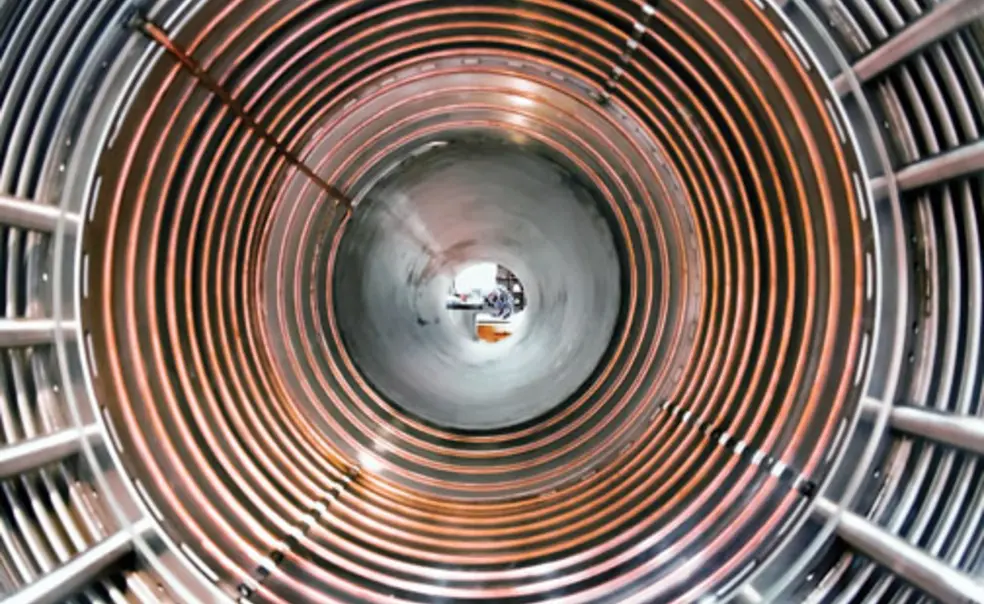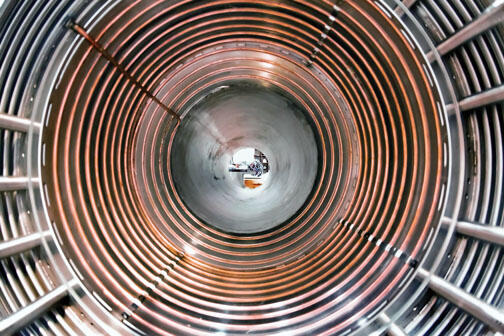In uncertain times, funding supports key PPPL project
Despite a squeeze on federal funding for domestic fusion-energy research, government support remains solid for a $94 million upgrade of the Princeton Plasma Physics Lab’s biggest and most important fusion project, the National Spherical Torus Experiment (NSTX).
The work will enhance the position of the NSTX as the world’s most powerful spherical tokamak, a device that houses extremely hot and supercharged gases called plasmas that can create fusion energy. With the relatively compact NSTX, researchers at PPPL are trying to prove the principle of how fusion energy would work by sustaining long-term plasma reactions to generate continuous energy for electrical power.
“NSTX works for a few seconds, but we can tell a lot even in that short duration about how a much longer reaction would work,” said Jonathan Menard *98, the project’s program director.
Cuts to other programs point to a precarious state of fusion research in the United States. MIT’s C-Mod project — one of three major fusion experiments in the U.S. along with NSTX and San Diego-based General Atomics’ fusion facility — is being shut down indefinitely due to budget cuts by the Department of Energy (DOE).
The tightening of domestic fusion-research funding results from pressure to reduce the federal budget deficit and the U.S. commitment to support an international collaboration that is building the world’s largest fusion reactor, called ITER (International Thermonuclear Experimental Reactor), in France.
Aside from the NSTX project, funding for other PPPL projects will shrink by about 10 percent over the next two years, according to lab director Stewart Prager. PPPL, one of 10 national science laboratories supported by the DOE’s Office of Science, has been operated by the University since it was created in 1951.
PPPL is receiving $79 million from the Energy Department this year; that amount is expected to drop to $71.8 million in the coming year, though Congress has not completed work on the federal budgets for fiscal years 2013 and 2014. A reduction of that size would cost about 36 jobs at PPPL, leaving a workforce of about 400, lab officials said. Smaller experiments, including research on how plasma processes occur in the cosmos and theoretical simulations of plasma, already have been hit hard, Prager said.
“Other nations are ramping up their domestic fusion programs, not ramping them down,” he said. “The U.S. should do the same, considering how important fusion is.”
A fusion-energy source, he said, would be essentially inexhaustible, clean (producing no greenhouse gases), safe (with no chance of catastrophic accidents), available to all nations (without dependence on local natural resources), and small in its land usage. “The attributes of fusion are nearly ideal,” Prager said.
An offshoot of research at the lab is a portable technology called MINDS (Miniature Integrated Nuclear Detection System), commercialized by New Jersey-based InSitech. In seconds, the system can detect low levels of nuclear material, the kind used in “dirty bombs,” in public places. MINDS has been tested in high-traffic public locations and is being used at the Port of Oakland. Prager said that such spinoffs are encouraged as the lab increases the scope of its research in both basic and applied science.
The 30-month NSTX upgrade, which will double the electric current and magnetic field, is about 60 percent complete; it is on schedule and within budget, Prager said. Earlier this year, the Fusion Sciences Advisory Committee, which advises the DOE on fusion-energy research, described the experiment as critical.
The upgrade “will provide ample research opportunities for five to 10 years’ worth of work at least,” said Michael Zarnstorff, deputy director for research at the lab.
A major concern stemming from the domestic research budget cuts is the loss of seasoned plasma experts and young physicists needed to continue the research in the next decades.
“If we eat into our base program too much, we won’t have the scientific means to take advantage of ITER once it is finished,” Menard said.












2 Responses
Daniel Jassby *70
9 Years AgoPrinceton and Fusion Energy
Here is PAW’s biennial panegyric to the nonexistent fusion-energy nirvana (Campus Notebook, July 10). But the usual litany of imaginary fusion-reactor benefits has changed from “inexhaustible, clean, safe, and cheap” to “inexhaustible, clean, safe, available to all nations.” PPPL director Stewart Prager has dropped the erroneous attribute “cheap,” presumably because the fusion world is choking on the $20 billion price tag for ITER. But the claim “available to all nations” is fallacious, because the components of fusion reactors require uncommon elements, including the following: lithium (for tritium production), helium (for cooling), niobium (for magnets), beryllium (to face the plasma and to multiply neutrons). There are few countries with significant resources of these elements.
Actually, Prager’s “ideal attributes” apply to solar-photovoltaic and solar-thermal energy sources. They have nothing to do with manmade fusion.
Kenneth W. Ford *53
9 Years AgoPrinceton and Fusion Energy
The Quest Research News from the Princeton Plasma Physics Laboratory, mailed with the July 10 PAW, brought to mind a seminal event for the lab.
Early in 1951, I was a junior researcher at the Los Alamos laboratory in New Mexico, on leave from my graduate studies in Princeton. I had followed my physics professor John Wheeler to Los Alamos to work on the development of the hydrogen bomb. When Princeton astrophysics professor Lyman Spitzer stopped for a visit after a Colorado ski holiday, he was eager to share a new idea on how to harness thermonuclear power for practical power generation.
Because of some security-clearance glitch, Spitzer’s admission to the lab was delayed, and he was stewing about it. So I and fellow Princeton graduate student John Toll *52 were dispatched to have lunch with Spitzer and calm him down. Over lunch, Spitzer told us why he thought a torus twisted into a figure eight might hold a hot plasma of deuterium long enough for thermonuclear “burning” to take place.
From this idea was born half of a new research enterprise, Project Matterhorn, established at Princeton less than six months later. Spitzer’s half was to be devoted to thermonuclear power. The other half, headed by Wheeler, was to pursue thermonuclear explosions. I have it on good authority that something like the following exchange took place in the office of Princeton’s chief financial officer, Roy Woodrow. Woodrow: “Your new enterprise needs a name.” Spitzer: “How about Project Matterhorn, symbolizing challenge and also reflective of the fact that I conceived the idea while skiing?” Wheeler: “OK, Lyman, you can name the project if I get to name your device. Let’s call it a stellarator.” Wheeler then headed Matterhorn B (for bomb), and Spitzer headed Matterhorn S (for stellarator).
As it turned out, controlled fusion power posed a far greater challenge than a fusion bomb. The first thermonuclear explosion occurred in late 1952 and Matterhorn B shut down soon after. Matterhorn S continues today as PPPL.